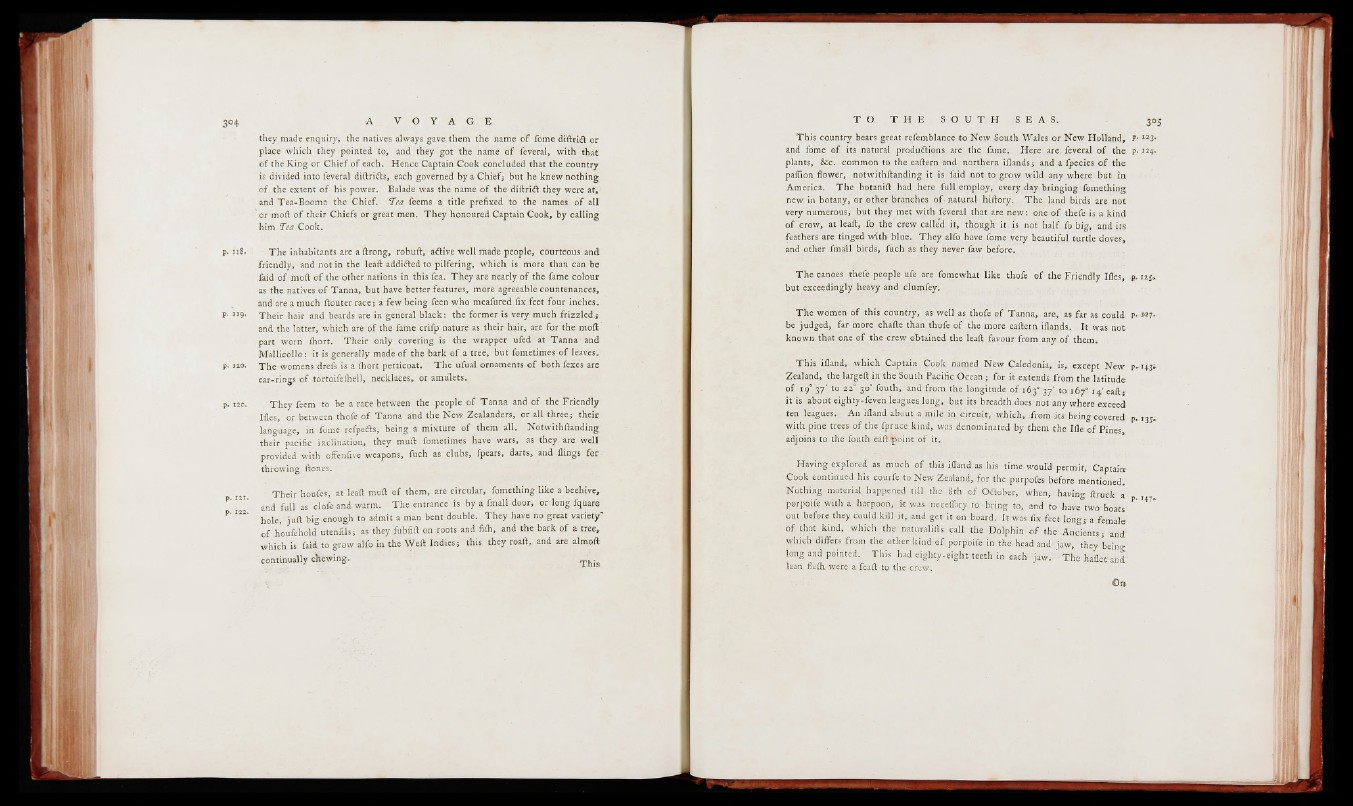
they made enquiry, the natives always gave them the name of fome diftridl or
place which they pointed to, and they got the name o f feveral, with that
of the King or Chief of each. Hence Captain Cook concluded that the country
is divided into feveral diftritts, each governed by a Chief; but he knew nothing
of the extent of his power. Balade was the name of the diftridl they were at,
and Tea-Booma the Chief. Tea feems a title prefixed to the names of all
or moil of their Chiefs or great men. They honoured Captain Cook, by calling
him Tea Cook.
p.-u8. The inhabitants are a ilrong, robuil, adtive well made people, courteous and
friendly, and not in the leaft addidted to pilfering, which is more than can be
faid of moil of the other nations in this fea. They are nearly of the fame colour
as the natives of Tanna, but have better features, more agreeable countenances,
and are a much ftouter race; a few being feen who meafured fix feet four inches,
p. 119, Their hair and beards are in general black: the former is very much frizzled;
and the latter, which are of the fame crifp nature as their hair; are for the moft
part worn ihort. Their only covering is the wrapper ufed at Tanna and
Mallicollo : it is generally made of the bark of a tree, but fometimes o f leaves,
p. 120. The womens drefs is a ihort petticoat. The ufual ornaments of both fexes are
ear-rings of tortoifeihell, necklaces, or amulets.
P* 120. They fcem to be a race between the people of Tanna and of the Friendly
Ifles, or between thofe of Tanna and the New Zealanders, or all three; their
language, in fome refpedts, being a mixture of them all. Notwithilanding
their pacific inclination, they muil fometimes have wars, as they are well
provided with offenfive weapons, fuch as clubs, fpears, darts, and flings for
throwing ftones; •;
Their houfes, at leaft moft of them, are circular, fomething like a beehive,
a n d f u l l a s clofe and warm. The entrance is by a fmall door, or long fquare
P 9 hole, juft big enough to admit a man bent double. They have no great variety'
of houfehold uteniils; as they fubfift on roots and fifli, and the bark of a tree,
which is faid to grow alfo in the Weft Indies; this they roaft, and are almoft
continually cliewing. Th;s
This country bears great refemblance to New South Wales or New Holland, P* I23*
and fome of its natural produdtions are the fame. Here are feveral of the p. 124*
plants, &c. common to the eailern and northern iilands; and a fpecies of the
paffion flower, notwithilanding it is faid not to grow wild any where but in
America. The botaniil had here full ,employ, every day bringing fomething
new in botany, or other branches of-natural hiilory. The land birds are. not
very numerous, but they met with feveral that are new: one of thefe is a kind
of crow, at leaft, fo the crew called it, though it is not half fo big, and its
feathers are tinged with blue. They alfo have fome very beautiful turtle doves,
and other fmall birds, fuch as they never faw before.
The canoes thefe people ufe are fomewhat like thofe of the Friendly Ifles, pv 125.
but exceedingly heavy and clumfey.
The women of this country, as well as thofe of Tanna, are, as far as could P* ®*7*
be judged, far more chafte than thofe of the more eailern iilands. It was not
known that one of the crew obtained the leaft favour from any of them.
This ifland, which Captain Cook named New Caledonia, is, except New p-143^
Zealand, the largeft in the South Pacific Ocean; for it extends from the latitude
of 190 37* to 220 30’ fouth, and from the longitude of 163° 37’ to 167° 14/ eaft;
it is about eighty-feven leagues long, but its breadth does not any where exceed
ten leagues. An ifland about a mile in circuit, which, from its being covered p. 13^
with pine trees of the fpruce kind, was denominated by them the Iile of Pines
adjoins to the fouth eaft point of it.
Having explored as much o f this illand as his time would permit, Captain>
Cook continued his courfe to New Zealand, for the. purpofes before mentioned.
Nothing material happened till the 8th of Goober, when, having ftruck a
porpoife with a harpoon, it was,,neqeffary'ti> bring to, and to have two boats ^
out before they could kill ¡t„ and. get it on board. Itwas fix feet long* a female
of that kind, which the natitaalifts-calli the Dolphin of the Ancients; and’
which differs from the other kind of porpoife in the head and jaw, they being
long and pointed. This had eighty-eight teeth in- each jaw. The kaflct and
lean fleih. were a feaft to the crew.
On